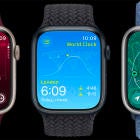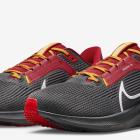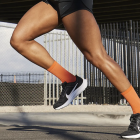
Apple officially rolled out the newly redesigned Apple Watch 9 and Ultra 2 that have the pulse oximetry features removed. While the newly sold devices still have the pulse oximeter hardware, the feature will be disabled. This change comes after courts ruled in favor of Masimo, the tech company that sued Apple for patent violations relating to the blood oxygen tracking technology.
While there's still plenty to love about the Apple Watch, the loss is a big hit for health-conscious people who rely on blood oxygen tracking. Using a fitness tracker to track general trends in your blood oxygen saturation levels over time can give you a sense of how much your body has recovered from your last workout and act as an early warning sign of heart or lung problems.
Shoppers who were looking forward to having access to that kind of data will now need to start looking for Apple Watch alternatives that still have blood oxygen tracking. To help you on your hunt, we've rounded up the best smartwatches that have a functional pulse oximeter and offer an overall experience that's similar to the latest Apple Watches.
The best Apple Watch alternatives with pulse oximeters
If you're set on getting a smartwatch with blood oxygen tracking, you've still got options. Keep reading for our favorite smartwatches that make great Apple Watch alternatives.
Best overall alternative to the Apple Watch 9: Google Pixel Watch 2

The Pixel Watch 2 is the latest model of Google's smartwatch. One of the biggest changes coming with the second generation watch is the improved heart rate sensor that's up to 40% more accurate than the first Pixel Watch even during intense workouts.
Borrowing tech from the now Google-owned Fitbit, the Pixel Watch has a pulse oximeter sensor. While you can't check blood oxygen levels on demand as you can with the Apple Watch, the Pixel Watch 2 monitors blood oxygen overnight and gives you a daily measure of your average levels.
It also added a skin temperature sensor and a continuous electrodermal activity (cEDA) sensor. A feature not even the Apple Watch has, the cEDA sensor continuously measures changes in the electrical currents on the surface of your skin to help track your stress levels.
Those new sensors give the Pixel Watch 2 the ability to offer new health insights like a sleep score and daily readiness score. One of the most impressive additions is "Body Response," a measure of stress and excitement that can send you a notification when it detects heightened stress and take you through guided breathing or mindfulness exercises to help you find your calm.
Beyond stress management, the new Pixel Watch 2 packs tons of new fitness tools. You can now do heart rate zone training with real-time feedback and coaching during your workout when you go above or below your target zone. You can also do pace training, with similar real-time alerts when you go above or below your target pace.
Get the stylish smartwatch while it's on sale for $300 (reduced from $350)
$300 at AmazonBest Apple Watch Ultra 2 alternative: Garmin Instinct 2 Solar

Are you an adventurer that needs an alternative to the Apple Watch Ultra 2 that offers similar durability, safety features and activity tracking support? We think the Garmin Instinct 2 Solar fits the bill.
Like the Apple Watches, the Garmin Instinct 2 lets you take a blood oxygen reading whenever you want, not just when you're asleep. You can also turn on automatic measurements to get periodic updates throughout the day.
One of the best smartwatches you can take on the trail, the Garmin Instinct 2 solar boasts durability that can withstand life's adventures, including shock resistance and water resistance up to 100 meters.
The GPS watch from Garmin connects to three global navigation satellite systems: GPS, GLONASS and Galileo so you'll be able to track your routes no matter how far off the beaten track you are. It also features "tracback" routing so if you get turned around, just let your watch guide you back to your starting point.
We like that track back feature for hikers, climbers, runners and adventurers to help navigate the back to your starting point. The battery life is a plus as well -- unlimited in smartwatch mode (thanks to solar charging) and up to 48 hours in GPS mode.
Train with pre-loaded activity profiles and monitor heart rate, activity and stress, to make this one of the most efficient smartwatches.
It also comes with advanced safety features like incident detection, which automatically detects an emergency during outdoor activities and sends a message to your emergency contacts with a LiveTrack link showing your real-time location.
The rugged outdoor smartwatch costs $380 on Amazon (reduced from $400).
$380 at AmazonBest fitness-focused alternative to the Apple Watch 9: Coros Pace 3

Built as a smartwatch for runners, but packed with features any fitness enthusiast would appreciate, the latest generation of the Coros Pace has some of the most advanced health and fitness features on the market. And you don't need to pay for a monthly subscription to use them.
The Coros Pace 3 offers on-demand blood oxygen readings and will even adjust based on your altitude (a factor that can impact blood oxygen levels).
The smartwatch also comes with free training plans and workouts, plus access to an advanced training hub on your desktop or phone that analyzes your past workouts and health data to give you detailed insights into your progress.
It's the only smartwatch on this list with a built-in rep counter to track your lifts, squats or other strength-training exercises that you usually have to count off in your head.
It also packs tons of advanced running metrics but its standout feature is probably its navigation system. Not only can you map your run and get back-to-start navigation when you're ready to head home, but you'll also get deviation alerts when you stray from the route you're following.
The Coros Pace 3 is light on non-fitness features like calling and digital payments. But the free training features and advanced health metrics, including a recovery score, training load, fatigue, marathon readiness score and so much more, make this such a great addition to your health and fitness journey.
You can get it for just $229 on Amazon.
$229 at AmazonShop more top-rated Apple Watch alternatives with pulse oximeters:
- A premium smartwatch for Android users: Samsung Galaxy Watch 6, $239 (reduced from $300)
- Garmin's best everyday smartwatch: Garmin Venu 3, $396 (reduced from $450)
- Best smartwatch under $100: Amazfit GTS 2 Mini Smart Watch, $80 (reduced from $100)
- A fitness-first smartwatch with Google Wallet and Alexa: Fitbit Versa 4, $150 (reduced from $199)
What is a pulse oximeter?
A pulse oximeter is a sensor that uses light to estimate how much oxygen is in your bloodstream at a given moment. The technology has been used in medicine for decades, but it's only in the last few years that consumers have been able to track it consistently with a wearable (like your smartwatch).
Oxygenated blood absorbs more infrared light, while blood with less oxygen in it absorbs red light (but less infrared light). The pulse oximeter sends beams of light through your skin and measures how much of different wavelengths of light are absorbed.
While fingertip pulse oximeters measure the amount of red and infrared light that make it through to the other side of your finger, a smartwatch pulse oximeter typically bases its measurement on how much light is reflected back up to the watch.
What is the purpose of tracking blood oxygen levels?
According to the CDC, 95% or higher is a healthy blood oxygen saturation level for adults and children. Anything at 90% or higher is considered normal.
If your levels drop below 90% consistently, it could be an early warning sign of a health problem like hypertension, heart disease or a respiratory disease. If your oxygen saturation levels are dropping steeply during the night, for example, it could be a sign of a sleep apnea.
For people who've already been diagnosed with a condition like asthma or high blood pressure, tracking your blood oxygen levels on a daily basis can be a useful way to manage your condition.
Even healthy adults with no chronic health conditions can use a smartwatch's pulse oximeter to estimate their fitness for the day. When your levels are lower than usual, take it as a sign that your body still needs more recovery time before your next high intensity workout. When your blood oxygen returns to your normal range, don't be afraid to push yourself during your next workout.
How accurate are blood oxygen measurements from smartwatches?
For prescription pulse oximeters, the FDA requires the device to meet minimum accuracy levels of around 4% to 6% of an arterial blood gas (ABG) test, a more precise test that requires testing a blood sample in a lab. So if a prescription pulse oximeter says your blood oxygen level is 90%, it's actually somewhere between 86% and 94%.
For non-prescription devices (like your smartwatch), there is no minimum requirement. But some studies have compared the accuracy of certain smartwatches to medical grade pulse oximeters. The Apple Watch, for example, consistently stayed within about 3% of a medical pulse oximeter reading. Other smartwatches that have been compared to medical pulse oximeters hovered between 3% and 6%. We couldn't find any studies comparing smartwatches directly to an arterial blood gas (ABG) test.
It's also important to note that the accuracy of any given reading can be influenced by a number of different factors. According to the National Institute of Health, some of the biggest variables are the following:
- Skin pigment. People with darker skin typically have less accurate pulse oximeter readings than people with lighter skin. At saturation levels above 90%, the accuracy is still close enough to use as a reference point. If your smartwatch shows your levels to be below 90%, you should talk to your doctor about getting an ABG test to confirm.
- Skin temperature. Colder skin makes it harder to get an accurate reading. So take measurements during outdoor winter workouts with a grain of salt.
- Altitude. Blood becomes less saturated with oxygen at higher altitudes because there is less oxygen in the air you're breathing. So if your levels drop on a ski trip, it shouldn't necessarily raise alarm bells unless they remain low once you get back down to sea level.
So your best bet is to use any smartwatch with a pulse oximeter as a rough reference point and look for general patterns. If the reading drops below 90% for one day, you probably don't need to be too concerned. If it stays below 90% for multiple days, it might be worth talking to your doctor about getting an ABG test.




















